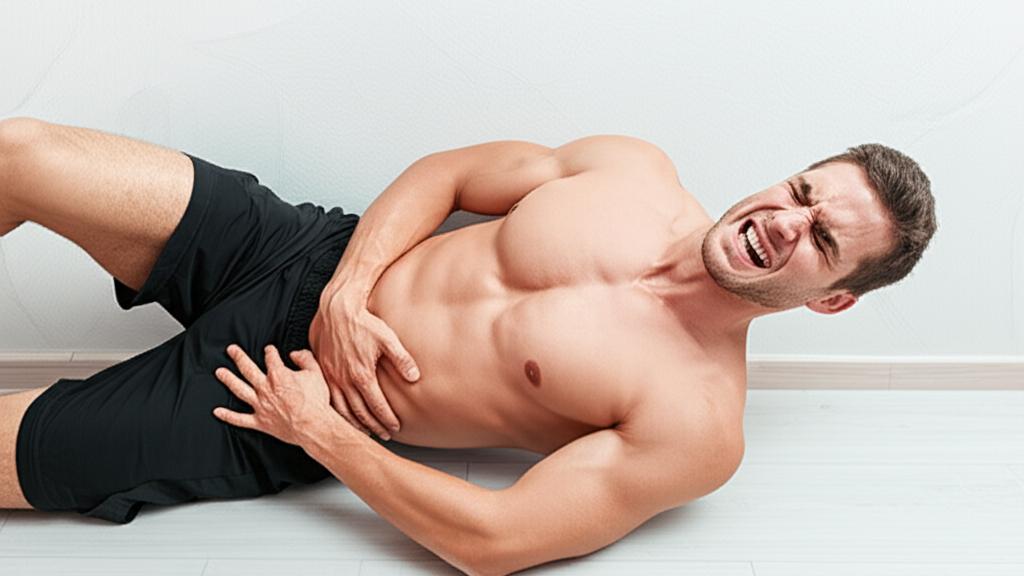Picture this: you’re giving it your all in your favorite sport – maybe it’s soccer, hockey, or even just a really intense workout. Then, wham. A sharp pain in your groin or lower belly. Or perhaps it’s not a sudden thing, but a dull ache that’s been getting worse, making it tough to sprint, twist, or even just sit up. If this sounds familiar, you might be dealing with what many call a sports hernia.
Now, that term ‘sports hernia’ can be a little misleading. When we doctors talk about it, we often use the name athletic pubalgia. It’s not typically a hernia in the classic sense, where part of your intestine pokes through a weak spot in your abdominal wall creating a visible bulge. Instead, a sports hernia is an injury – often a tear – to the soft tissues, like muscles or tendons, in your lower abdomen or groin area. Sometimes, this injury can also irritate nearby nerves, which adds to the discomfort. It’s a common one I see, especially in folks who are really active.
Understanding the Injury: Where and Why
So, where exactly does this sports hernia happen? We’re usually looking at the soft tissues around your lower tummy and groin. This could be:
- Those oblique muscles in your lower abdomen.
- The tendons that connect these oblique muscles to your pubic bone (that’s part of your pelvis).
- Or, the tendons that link your thigh muscles to that same pubic bone.
Sports Hernia vs. Regular Hernia: What’s the Difference?
I know, the names are confusing! A sports hernia, or athletic pubalgia, as we’ve said, is about damage to those soft tissues – a muscle or tendon tear, usually. The pain from a regular hernia? That’s different. That’s when there’s an actual gap in your abdominal muscle, and tissue (like your intestine) pokes through, often causing a noticeable bulge. It’s possible for a sports hernia to eventually lead to a traditional hernia, but we see them as separate issues.
What Causes a Sports Hernia?
What brings on a sports hernia? Well, it often comes down to activities that involve a lot of forceful, repetitive movements, especially quick changes in direction or those powerful twisting motions of the pelvis. Think about sports like:
- Ice hockey
- Soccer
- Football
- Wrestling
- Even things like skiing, tennis, or hurdling.
But you don’t have to be a pro athlete. Sometimes it’s from:
- Really intense abdominal or hip exercises, especially if the form isn’t quite right.
- A bit of weakness in the core abdominal muscles.
- Or an imbalance in strength between your hip muscles and your abdominal muscles.
It’s pretty common, actually – about 5% of adult athletes might run into this each year. We tend to see it more in men, and often in athletes in their mid-to-late twenties. It’s less common in kids or older folks, but it can happen.
Recognizing the Signs: Symptoms of a Sports Hernia
So, what would you feel if you had a sports hernia? The main thing is that persistent, nagging pain in your lower abdomen or groin. It might feel like:
- A sudden, sharp pain when the injury first happens.
- An ongoing dull or burning ache.
- Pain that’s tricky to pinpoint – just a general area of discomfort.
- Pain that seems to travel down towards the scrotum (in men) or the inner thigh.
- It really flares up when you’re active – sprinting, twisting, kicking, even doing sit-ups.
- Sometimes, even coughing or sneezing can make it twinge in your groin.
- It often gets bad enough that you have to stop playing your sport or seriously cut back.
- The pain might ease up with rest, but then it comes right back when you get active again. Sound familiar?
Getting to the Bottom of It: Diagnosis
Figuring out if it’s truly a sports hernia can be a bit of a puzzle. Why? Because lots of things can cause groin pain – issues with the hip joint like osteoarthrosis, problems in the rectum or testicles, even a tiny fracture in the pelvis. Plus, pain can be tricky; sometimes an injury elsewhere in your body, like your leg, can make your groin hurt. We call that referred pain. Your groin has a lot of nerves, so it’s a busy intersection!
So, when you come to see me, we’ll start by having a good chat. I’ll want to hear all about your symptoms, when the pain started, and what makes it better or worse. Then, I’ll do a physical exam. I might ask you to do a sit-up or tense your tummy muscles while I provide a bit of resistance. If it’s a sports hernia, these movements will likely be painful.
To get a clearer picture and rule out other possibilities, we might suggest some imaging tests:
- An MRI (Magnetic Resonance Imaging) is often very helpful.
- Sometimes an X-ray to check the bones.
- An Ultrasound can show soft tissue problems.
- A CT scan (Computed Tomography) might be used.
- Less commonly, a bone scan.
These tests help us confirm if it’s athletic pubalgia or something else that needs a different approach.
The Path to Recovery: Treatment Options
Alright, so if we determine it is a sports hernia, what do we do? Our main goals are to get that pain under control, get your movement back, rebuild strength, and get you back to doing what you love, whether that’s competitive sports or just your regular activities. The plan really depends on how severe it is, your age, your overall health, and what you’re aiming to get back to.
We usually start with non-surgical approaches first. Let’s see if we can get it sorted without an operation. This might involve:
- Rest: Especially in the first week or two after it happens. Ice can be your friend here too.
- Physical Therapy: After a couple of weeks, we’d likely get you started with a physical therapist. They’re fantastic at guiding you through exercises to improve strength and flexibility in your abdominal and inner thigh muscles. This is super important.
- Anti-inflammatory Medications: Things like ibuprofen or naproxen can help ease pain and reduce swelling. I might suggest these.
- Corticosteroids: If the usual anti-inflammatories aren’t cutting it, sometimes a cortisone injection (a type of steroid) can help calm things down.
Now, if you’re still having significant pain after a few months – say, two to six months – of trying these non-surgical treatments, then we might start talking about surgery. The type of surgery depends on exactly which muscles or tendons are injured and how badly. It could be:
- Laparoscopic surgery: This is a minimally invasive approach. The surgeon makes tiny cuts and uses a small camera and special tools. It usually means a quicker recovery.
- Open surgery: This involves a more traditional incision so the surgeon can directly see and repair the area.
After surgery, physical therapy and a tailored rehabilitation plan are key to getting you back to full strength and activity.
And you might wonder, ‘Will a sports hernia just heal on its own?’ Usually, no. Unlike a simple muscle strain that might get better with just rest, a sports hernia typically needs some active treatment, whether that’s dedicated physical therapy or, in some cases, surgery.
The Role of Physical Therapy
When we talk about physical therapy for a sports hernia, the aim is to carefully build up strength and flexibility in your core and hip muscles without making things worse. Your therapist will create a plan just for you, thinking about your specific injury and the activities you want to get back to. This might include:
- Core-strengthening exercises
- Gentle stretching
- Activities like swimming or yoga (modified, of course)
- Exercises to improve your posture and stability
- Working with medicine balls or resistance bands as you get stronger.
What to Expect: Recovery and Outlook
How long does it take to get better? Well, it varies. If physical therapy is the main treatment, many people feel a lot better after about six to eight weeks of consistent effort.
If surgery is needed, the success rates are generally very good – around 90% for both open and laparoscopic procedures. With good post-surgery rehab, most folks can get back to their sports and activities within six to twelve weeks.
Sometimes, and this is something to be aware of, the tissue can tear again when you return to intense activity. If that happens, another repair might be needed. It’s not common, but it’s possible.
Can You Prevent a Sports Hernia?
Can you stop a sports hernia from happening in the first place? That’s the million-dollar question, isn’t it? It can be tough, especially with the kind of stress some sports put on the pelvis and hips. But, if you’re in a high-risk sport, we might talk about a prevention program. This could involve:
- Specific abdominal and core strengthening exercises.
- Exercises to beef up your hip muscles.
- Work on flexibility to reduce strain across that lower abdominal area where these injuries often pop up.
When to Reach Out
So, if you’re having any of those symptoms we talked about – that persistent groin or lower belly pain, especially with activity – please don’t just try to ‘tough it out.’ Come and see us. As I mentioned, sports hernias don’t usually get better on their own, and we can help figure out what’s going on and get you on the right track.
And if you’re already being treated for a sports hernia and things seem to be getting worse, or new symptoms pop up, definitely let your healthcare team know.
When we chat, it might be helpful to have some questions ready. Things like:
- What kind of sports hernia (or athletic pubalgia) do you think I have?
- What’s our game plan for treatment?
- Do you think I’ll need surgery?
- Realistically, how long will recovery take?
- When can I start exercising or playing my sport again?
- And importantly, what can I do to try and prevent this from coming back?
Key Things to Remember About Sports Hernia
- A sports hernia (also known as athletic pubalgia) is a soft tissue injury (like a tear) in your lower abdomen or groin, not the kind of hernia where something bulges out.
- It’s often seen in sports that involve a lot of twisting or sudden changes of direction, but it can happen to non-athletes too.
- The main symptom is ongoing pain in the lower belly or groin that usually gets worse with activity and can be tricky to pinpoint.
- To figure it out, we’ll do a physical exam and often use imaging tests like an MRI.
- Treatment typically starts with conservative measures like rest, physical therapy, and anti-inflammatory medications. If these don’t bring relief, surgery might be an option.
- Don’t ignore that persistent groin pain. It’s always best to see your doctor to get a proper diagnosis and a treatment plan for your sports hernia.
Dealing with an injury like this can be frustrating, I know. But you’re not alone, and we’re here to help you navigate it and get you moving comfortably again.


